Japanese gardens are a harmonious blend of nature, art, and tranquility, and the right fence can elevate this serene atmosphere to new heights. Whether you're drawn to the timeless elegance of bamboo panel fences or the rustic charm of wabi-sabi wooden designs, Japanese-inspired fences offer endless possibilities to transform your outdoor space. These fences are more than just boundaries; they are carefully crafted elements that reflect the principles of balance, simplicity, and natural beauty. From shoji-inspired patterns to moss-covered stone walls, each design tells a story and creates a sense of calm. If you're looking to infuse your garden with a touch of Japanese aesthetics, exploring these **40 Japanese fence ideas for serene gardens** will inspire you to create a space that feels both peaceful and purposeful.

1. Bamboo Panel Fences
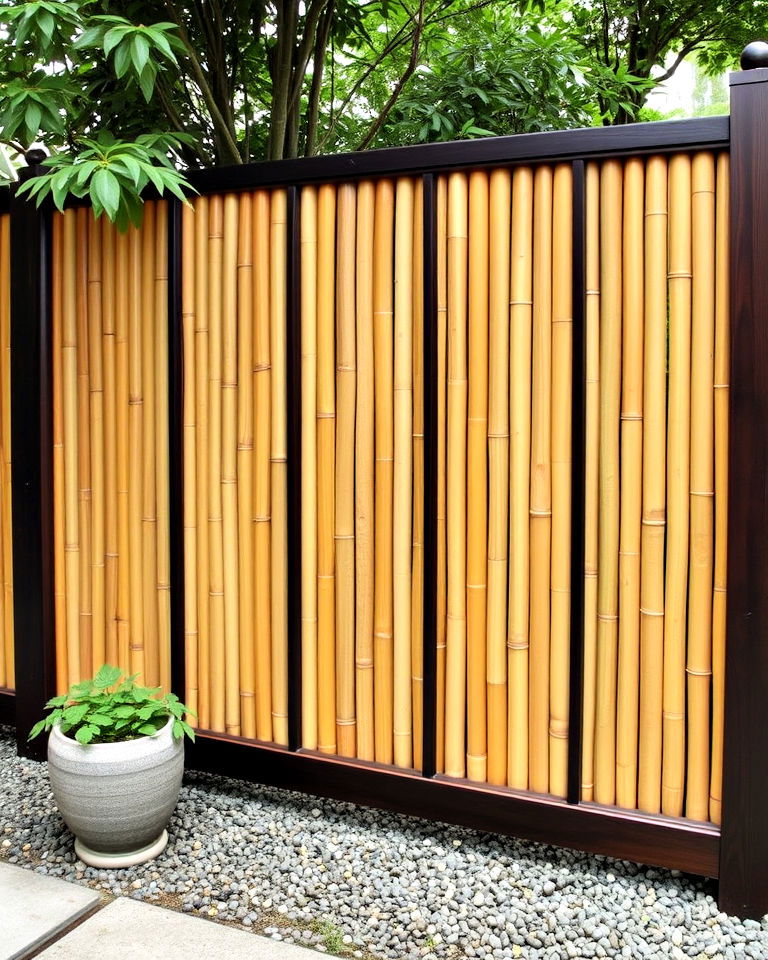
With their timeless beauty, bamboo panel fences reflect the essence of Japanese simplicity. These fences use slender bamboo stalks arranged vertically or horizontally, creating a clean, natural aesthetic. Bamboo's durability ensures longevity while maintaining its rustic charm. Often framed with dark-stained wood for contrast, they blend perfectly with gardens, pathways, or koi ponds. Additionally, bamboo panels are lightweight yet robust, making them ideal for privacy and decorative use while promoting harmony with nature.
2. Tatami-Style Fences
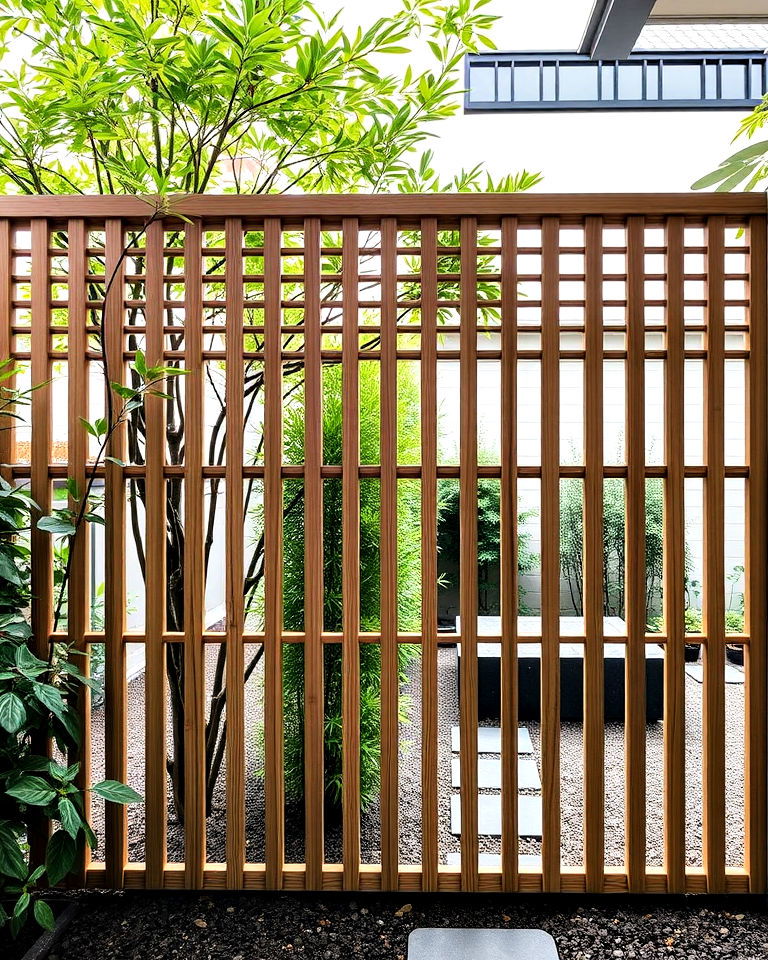
Inspired by traditional Japanese interiors, tatami-style fences feature horizontal wooden or bamboo slats. These fences mimic the geometric balance of tatami mats, evoking elegance and serenity. Ideal for smaller spaces, their minimalist design creates an intimate yet open ambiance. Natural tones seamlessly complement greenery, enhancing the tranquil setting. Perfect for gardens or walkways, tatami-style fences pair well with stepping stones, lanterns, or water features, providing a harmonious balance between function and aesthetics.
3. Shoji-Inspired Fences
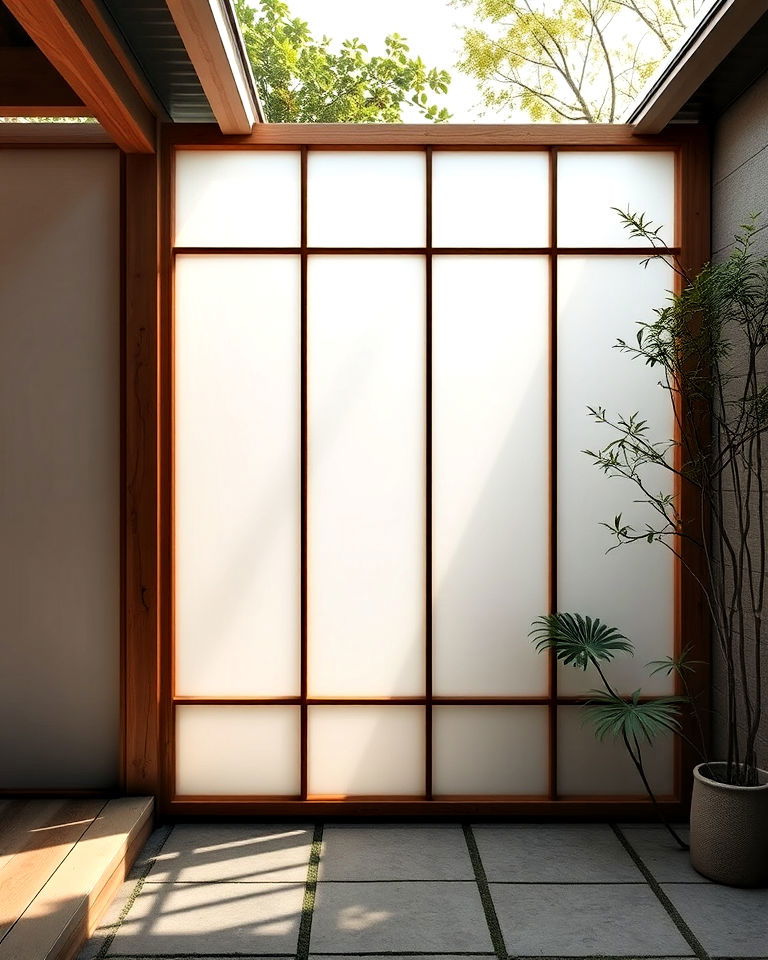
Incorporating translucent materials like frosted acrylic or rice paper, shoji-inspired fences resemble traditional Japanese sliding screens. These fences allow soft light to filter through while maintaining privacy, creating a dreamy atmosphere. Wooden frames add a natural warmth that complements both modern and traditional designs. Perfect for patios or gardens, they introduce a sophisticated yet calming element, making them a standout feature in any outdoor setting. Their delicate appearance is balanced by their practical functionality.
4. Stone and Wood Combination Fences

Combining the solidity of stone with the natural warmth of wood, these fences embody Japanese craftsmanship. The stone base offers durability and stability, while the wooden panels add elegance and texture. This dual-material design is perfect for creating a striking visual contrast that enhances any outdoor environment. Ideal for larger spaces or perimeter walls, the fusion of earthy tones adds depth and character. Stone and wood combination fences bring timeless sophistication to Japanese-inspired landscapes.
5. Woven Bamboo Fences

Woven bamboo fences bring a unique textural element to gardens and yards. Crafted by interweaving slender bamboo strips, these fences create a beautifully intricate pattern. Their lightweight design is highly durable, offering privacy without appearing bulky. The weaving technique highlights traditional craftsmanship, blending seamlessly into natural surroundings. Often paired with wooden frames or stone bases, these fences are ideal for defining spaces while enhancing the overall aesthetic of Japanese-inspired landscaping.
6. Open Slatted Wooden Fences
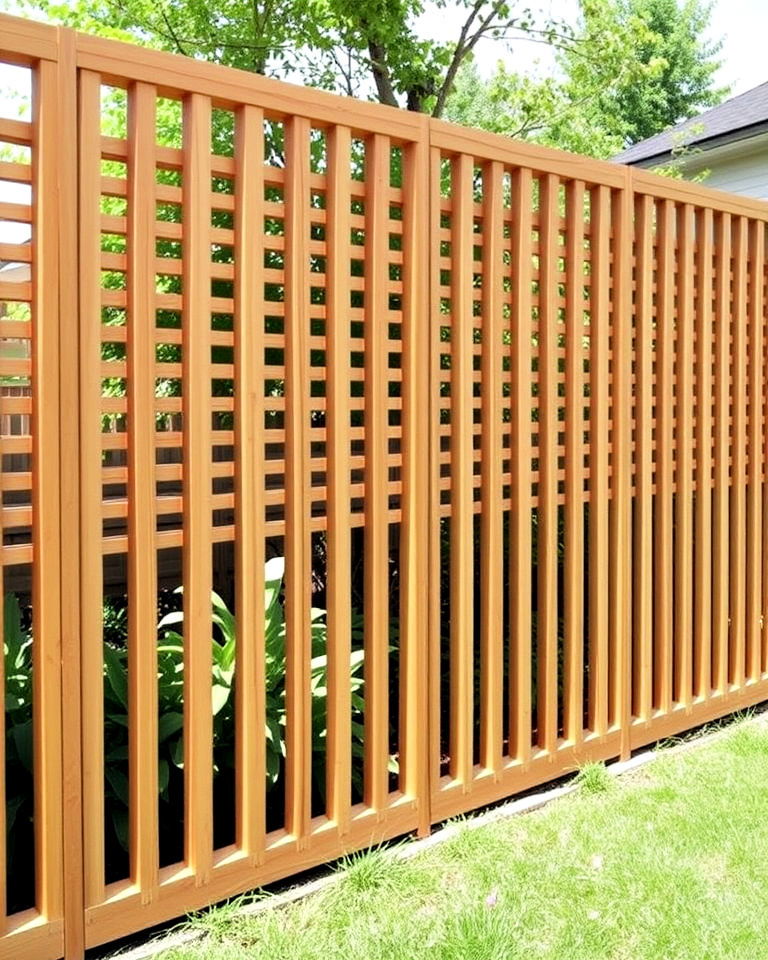
Open slatted wooden fences provide a minimalist approach to traditional Japanese design. Featuring evenly spaced horizontal slats, they create a balance of privacy and openness, allowing light and air to flow freely. This modern yet classic design works well for framing gardens or patios, emphasizing simplicity and structure. The natural tones of wood integrate harmoniously with plants and greenery, making them a versatile option for both urban and rural landscapes.
7. Zig-Zag Bamboo Fences

Designed with creativity in mind, zig-zag bamboo fences offer an eye-catching variation of traditional bamboo styles. The stalks are arranged in a crisscross pattern, forming dynamic angles that add depth and movement. This design is perfect for creating focal points in gardens or lining pathways. Lightweight yet durable, zig-zag bamboo fences exude a handcrafted charm that emphasizes the artistic side of Japanese design, blending perfectly with lush greenery and stone accents.
8. Black-Stained Wooden Fences

Black-stained wooden fences bring a bold, modern twist to traditional Japanese aesthetics. The dark stain enhances the wood’s grain while providing a striking contrast to vibrant green foliage. These fences often feature clean, vertical slats for a sleek, minimalist look. Ideal for contemporary gardens or urban settings, the deep black tones create a dramatic yet elegant backdrop, allowing other design elements, such as plants or water features, to take center stage.
9. Natural Hedge Fences
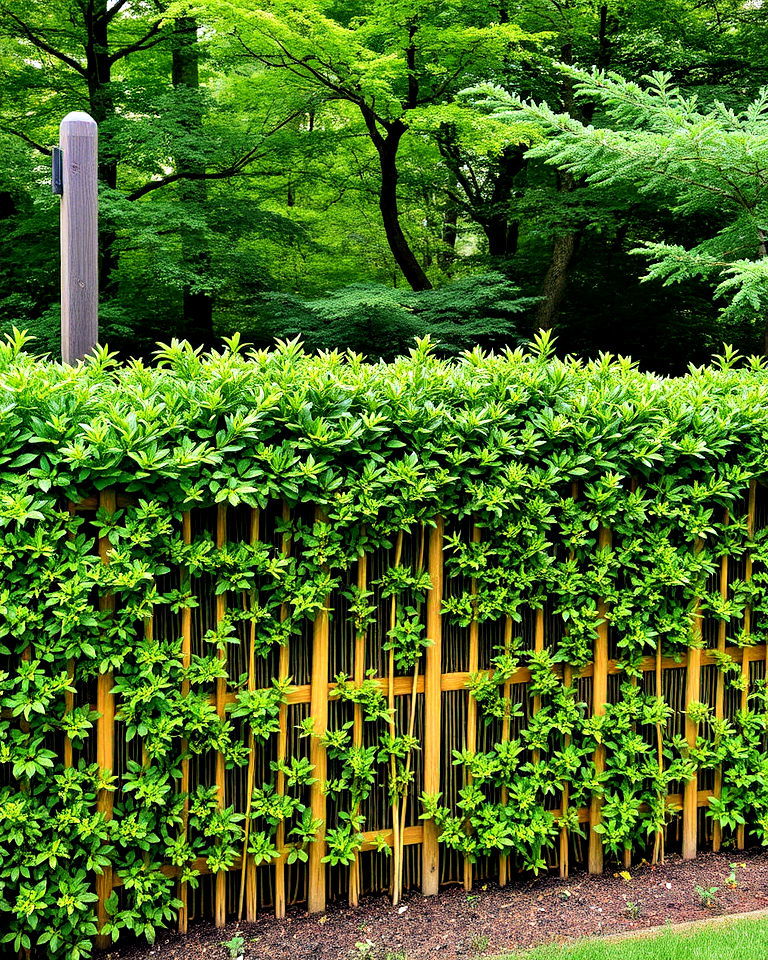
Surprisingly versatile, natural hedge fences combine greenery with functional fencing. Using dense plants like boxwood or bamboo grass, these fences create a lush, living barrier that exudes tranquility. Hedge fences are perfect for blending man-made structures into the natural environment, offering privacy while maintaining an organic feel. They also provide seasonal variety, as flowers, berries, or foliage changes throughout the year, making them an ever-evolving feature of Japanese-inspired gardens.
10. Split Bamboo Fences
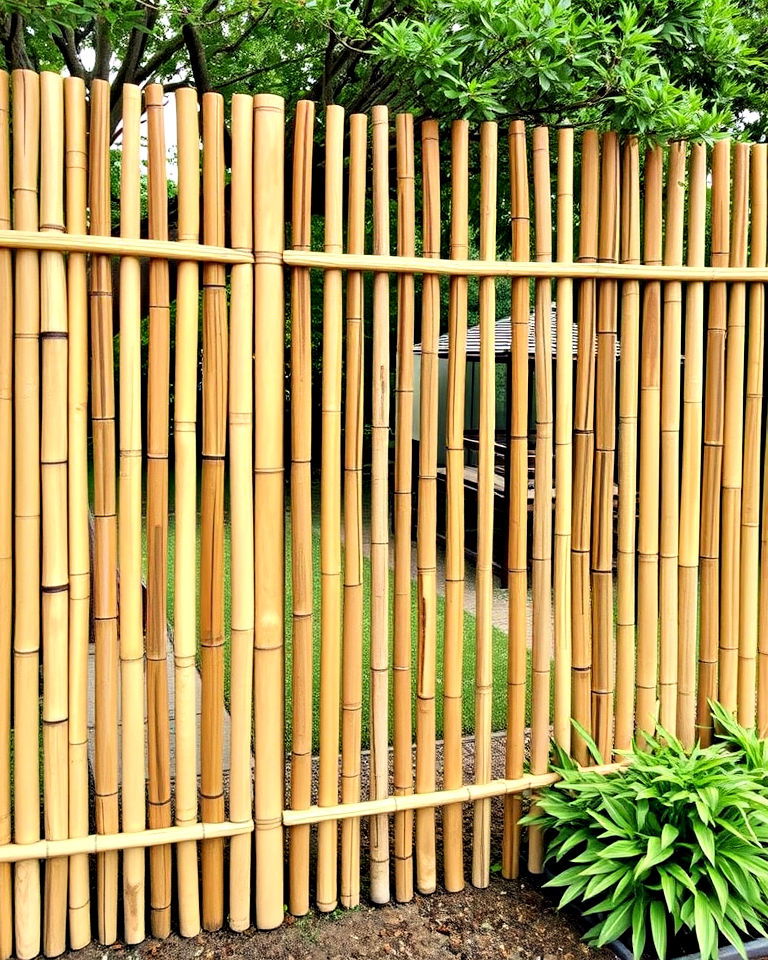
Split bamboo fences showcase traditional craftsmanship with their simple, rustic design. Made by splitting bamboo stalks into thinner strips, these fences are arranged vertically or diagonally for varied effects. Their lightweight nature makes them easy to install while maintaining durability. Perfect for small gardens, tea houses, or walkways, split bamboo fences harmonize beautifully with stones, lanterns, and water features. They emphasize the natural beauty of bamboo while adding texture and character to outdoor spaces.
11. Vertical Cedar Fences
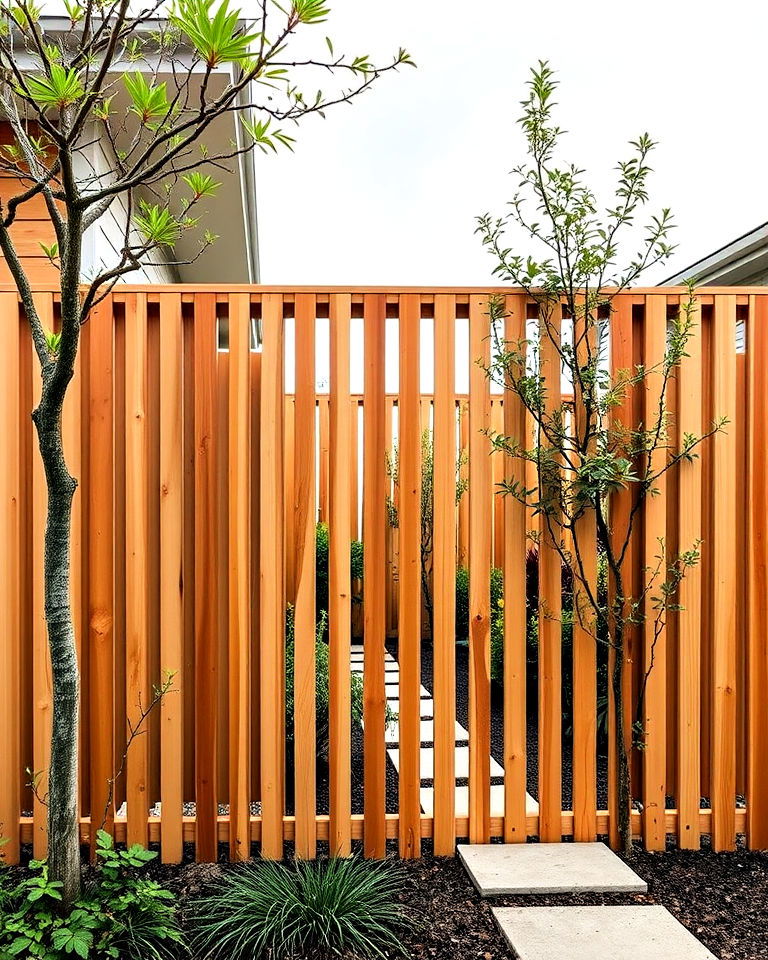
Crafted from cedar wood, vertical cedar fences offer a sleek, modern take on Japanese fence design. Their clean, straight lines emphasize simplicity and symmetry, making them ideal for framing gardens or courtyards. Cedar's natural resistance to weathering ensures durability while maintaining a beautiful, earthy appearance. Often left untreated or lightly stained, these fences blend seamlessly with natural surroundings, enhancing the tranquil ambiance of outdoor spaces. Vertical cedar fences are both functional and visually appealing, perfect for minimalist landscapes.
12. Irregular Wood Plank Fences
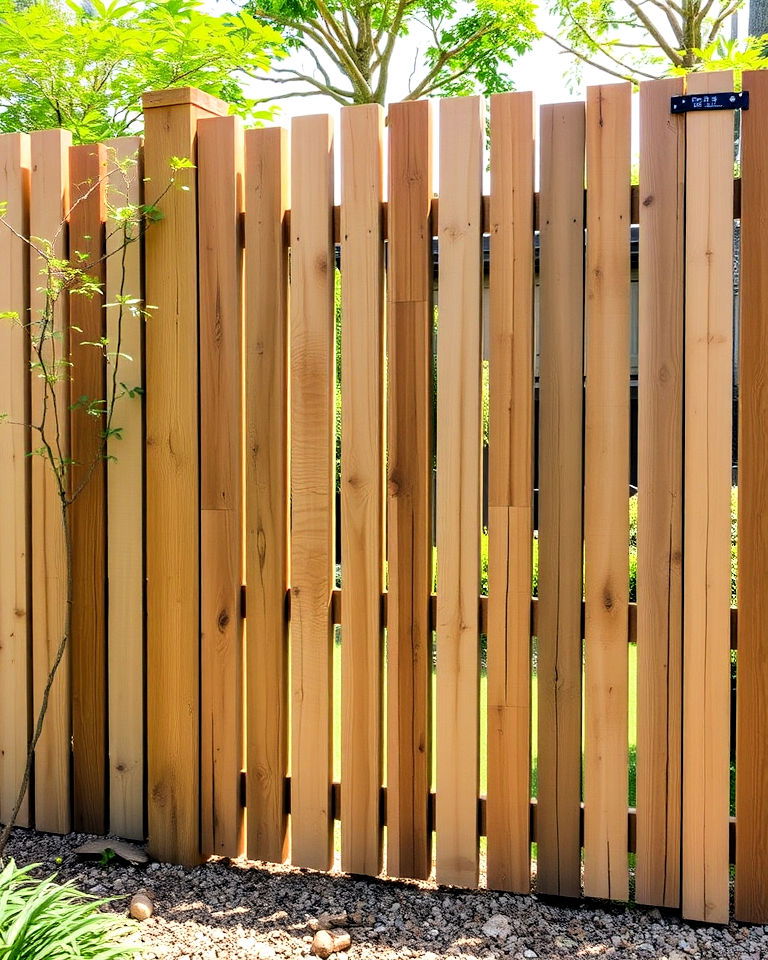
Designed for a more organic look, irregular wood plank fences feature varying widths and heights of wooden slats. This asymmetrical arrangement evokes a natural, handcrafted feel that reflects the rustic side of Japanese design. Perfect for gardens or pathways, these fences emphasize simplicity while adding visual interest. The use of untreated wood enhances the raw, earthy vibe, and the gaps between planks allow light and air to pass through, making them both functional and artistic.
13. Garden Gate Fences
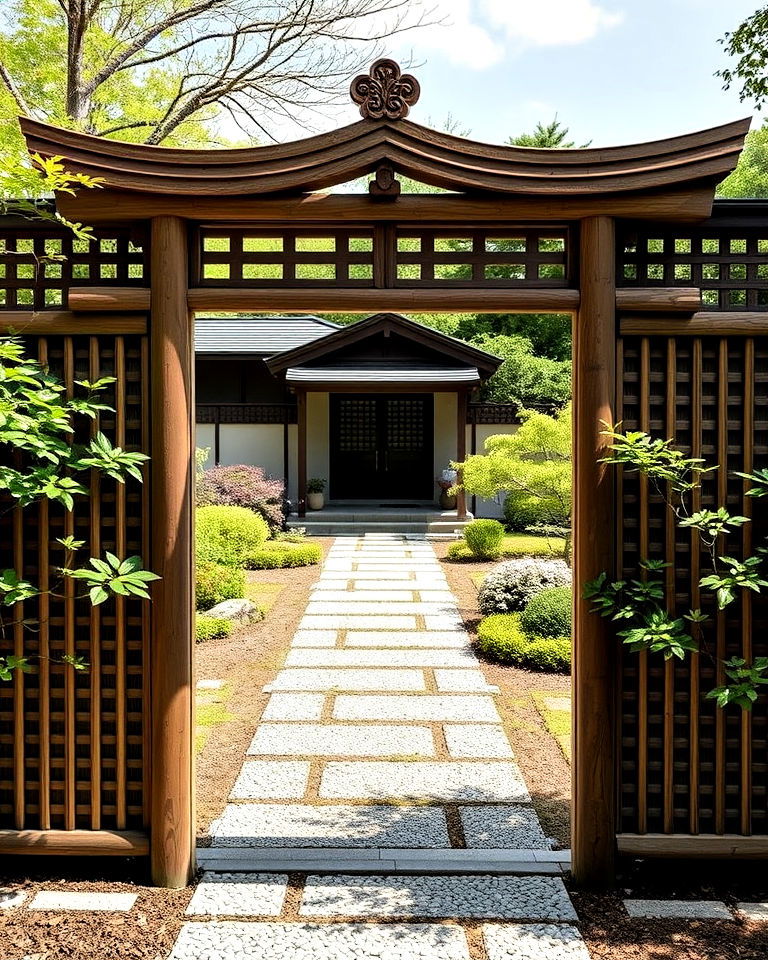
A garden gate fence combines traditional Japanese craftsmanship with functionality, serving as an inviting entrance to gardens or courtyards. Typically constructed from wood or bamboo, these fences often feature intricate carvings or latticework for added detail. The gate itself becomes a focal point, framed by fencing that seamlessly blends with the surrounding landscape. Garden gate fences symbolize hospitality and elegance, offering a welcoming transition between spaces while maintaining the serene aesthetics of Japanese design.
14. Horizontal Slatted Fences
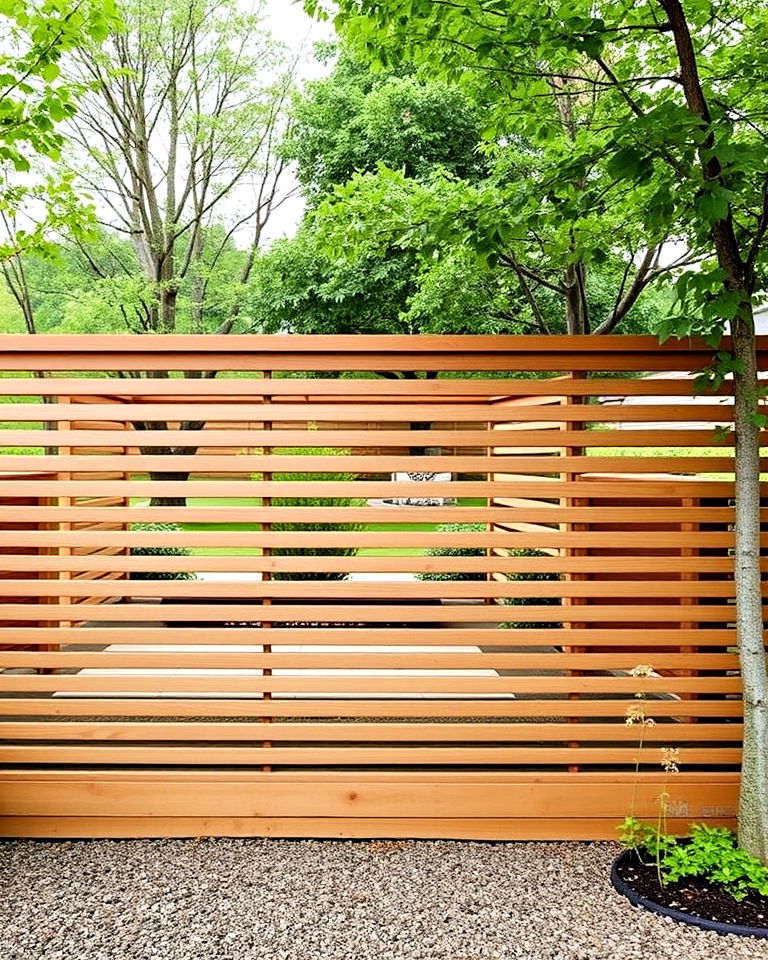
Horizontal slatted fences bring a contemporary twist to traditional Japanese fencing. Their evenly spaced wooden slats create a sleek, linear look that complements modern and classic gardens alike. This design allows for partial privacy while maintaining an open, airy feel, ideal for enclosing patios or seating areas. The natural wood tones add warmth and depth, while the horizontal orientation emphasizes the flow and expansiveness of the surrounding landscape.
15. Reed Fences

Made from tightly bundled reeds, reed fences are a lightweight and eco-friendly option for Japanese-inspired designs. These fences exude rustic charm, offering a simple yet elegant solution for garden enclosures or dividers. Reed fences are easy to install and blend effortlessly into natural surroundings. Often paired with wooden frames or stone accents, they are perfect for creating a private, serene space while emphasizing a connection to the natural world.
16. Circular Window Fences
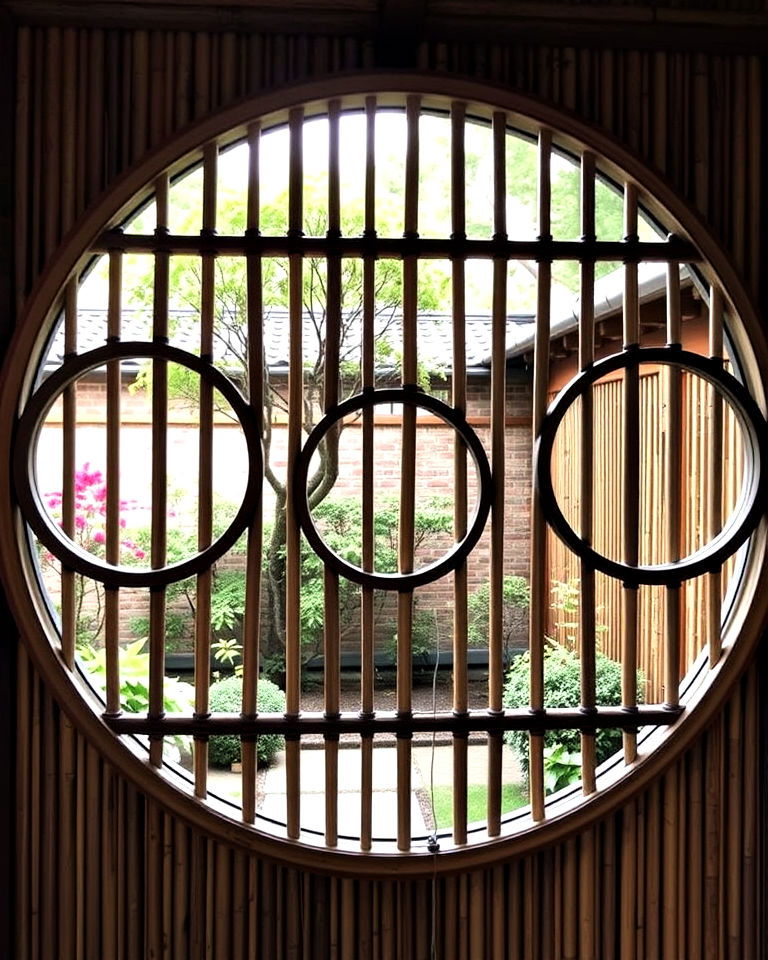
From ancient traditions, circular window fences draw inspiration from Japanese "moon gates," incorporating round openings within bamboo or wood structures. These artistic windows create a dynamic visual by framing glimpses of the garden beyond. Ideal for courtyards or private areas, they balance privacy with intrigue. Often accented with intricate woodwork, these fences elevate outdoor spaces with their blend of functionality and elegance, offering a unique focal point that reflects Japanese architectural harmony.
17. Lattice-Style Bamboo Fences
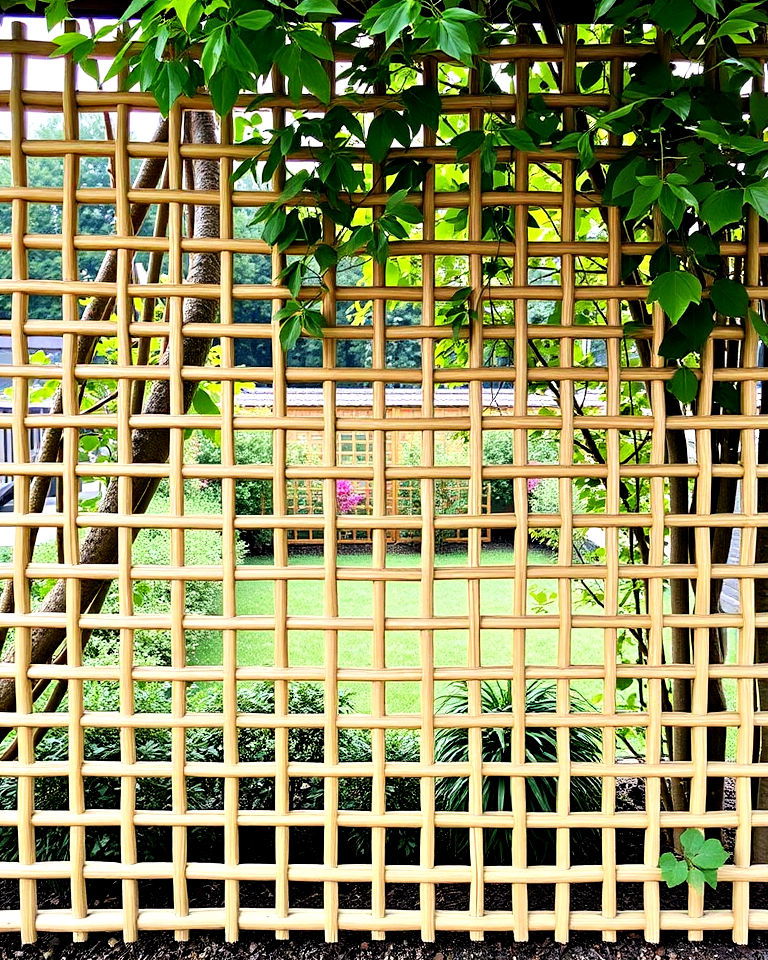
With a timeless appeal, lattice-style bamboo fences feature intersecting patterns of slim bamboo stalks. These delicate grids allow light and air to pass through, maintaining a sense of openness. Perfect as garden dividers or decorative elements, these fences work beautifully with climbing plants, enhancing their visual appeal. Their lightweight yet durable construction blends traditional craftsmanship with contemporary functionality, creating a serene and stylish barrier that complements natural landscapes.
18. Rope and Wood Fences
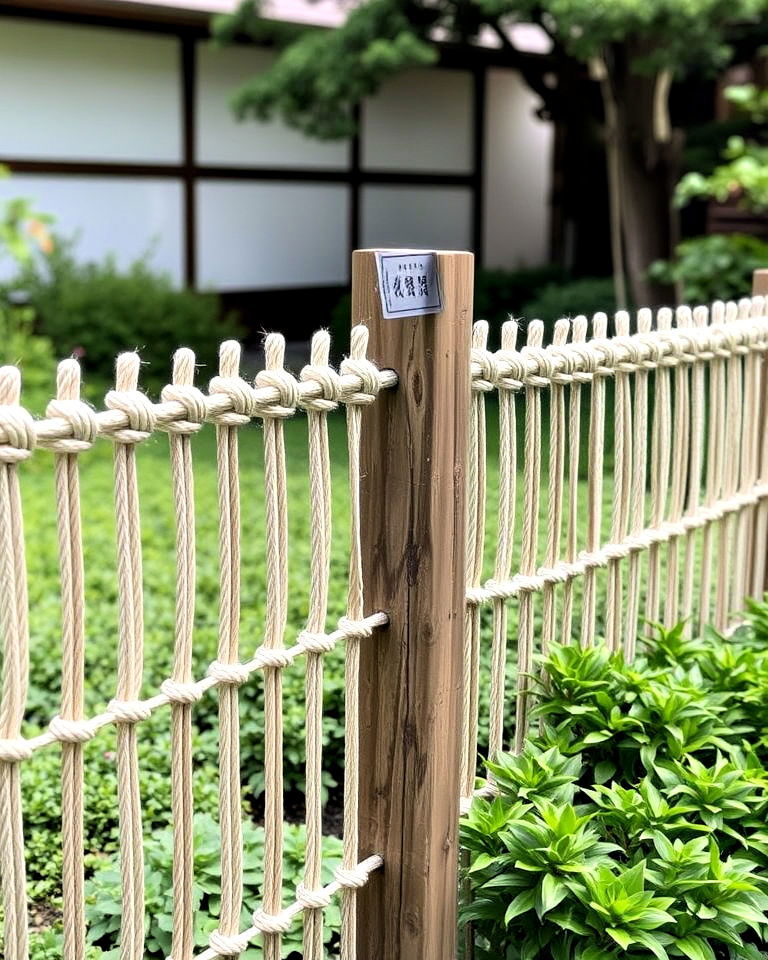
In a nod to rustic elegance, rope and wood fences incorporate natural fibers to complement sturdy wooden posts. The ropes, often tied in intricate patterns, add texture and character while serving as functional dividers. Ideal for marking garden boundaries or pathways, these fences evoke a sense of simplicity and connection to nature. Their versatility and minimalist design make them a unique addition to Japanese-inspired landscapes, blending effortlessly into greenery.
19. Low Zen Garden Fences

Within serene Zen gardens, low fences crafted from bamboo or wood subtly frame key elements like stones or sand designs. These understated barriers define spaces without obstructing views, preserving the tranquility of the setting. Their minimalist design emphasizes harmony, enhancing pathways or koi ponds with their simplicity. Low Zen garden fences are perfect for cultivating a meditative ambiance while showcasing the garden’s natural beauty and artistic elements.
20. Curved Bamboo Fences
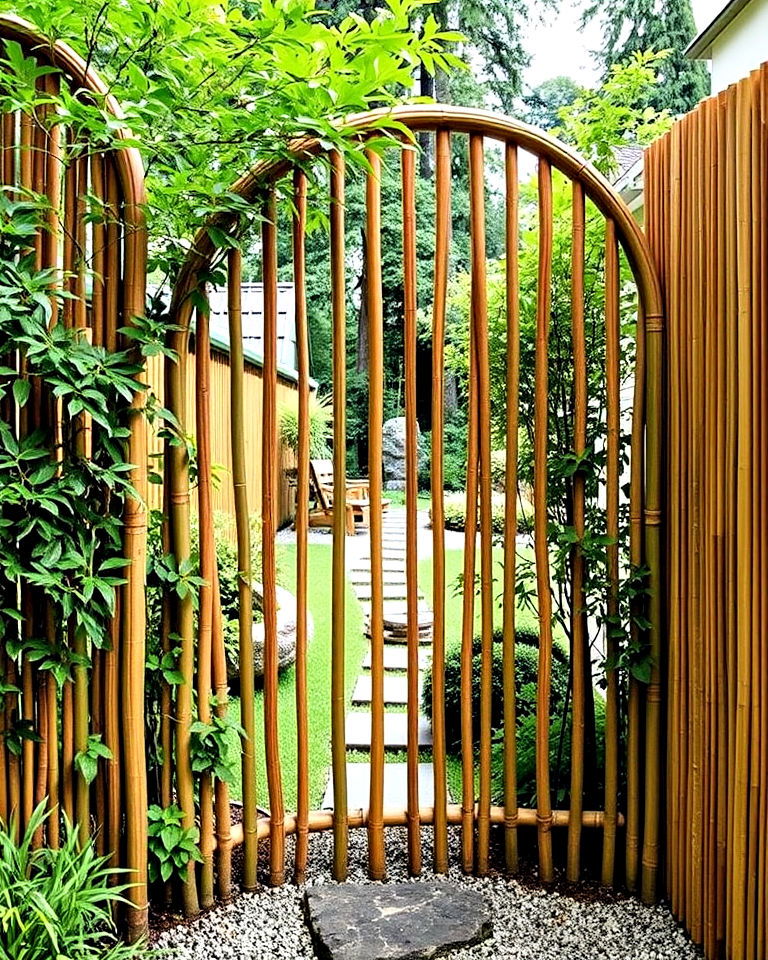
Against the rigidity of straight lines, curved bamboo fences introduce fluidity and motion to outdoor spaces. Designed with gently arched bamboo slats, these fences mimic the natural flow of the landscape. Ideal for creating intimate nooks or framing pathways, they bring a sense of softness and artistry. The organic shape of these fences blends harmoniously with greenery and stone features, embodying the Japanese principle of balance and harmony.
21. Sliding Panel Fences
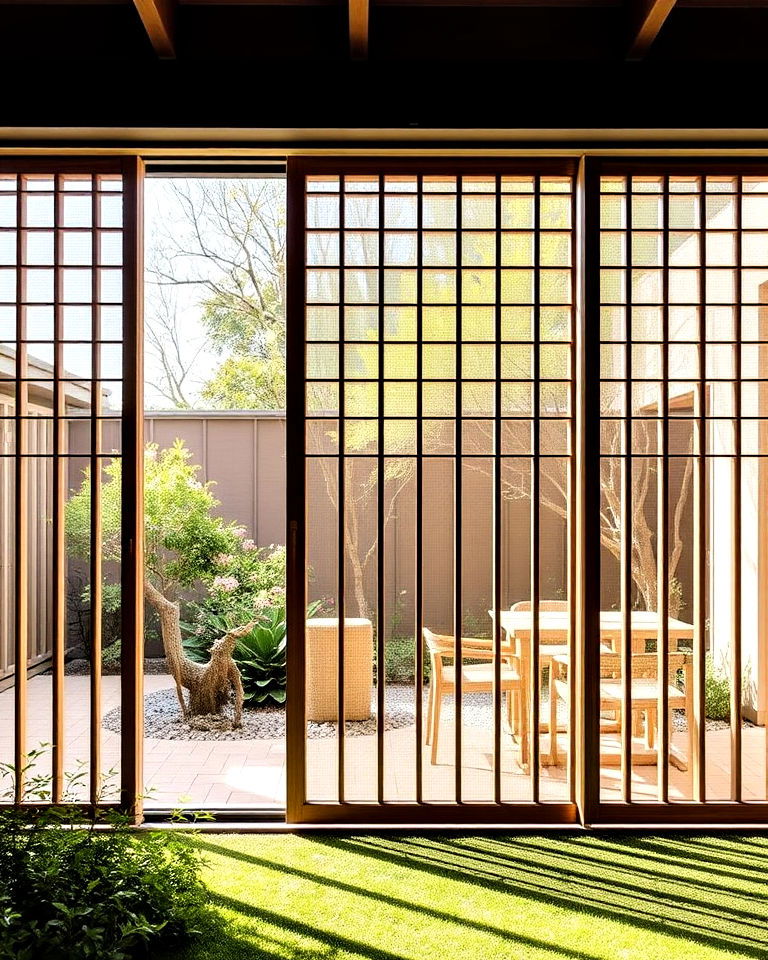
As a versatile design choice, sliding panel fences borrow from traditional Japanese room dividers. These movable wooden or bamboo panels allow for adjustable privacy and light control. Perfect for patios or small gardens, they offer flexibility while maintaining an elegant aesthetic. The clean lines and natural tones of sliding panel fences enhance the functionality of outdoor spaces, adding a practical yet artistic touch to Japanese-inspired settings.
22. Moss-Covered Stone Fences
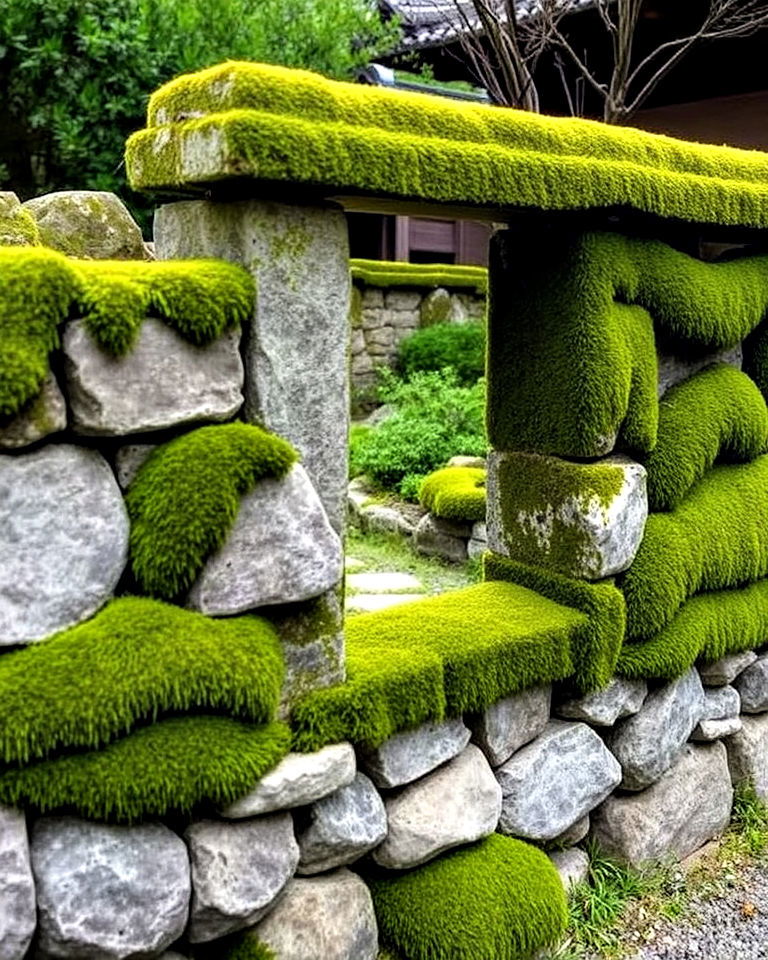
From nature’s textures, moss-covered stone fences create a timeless, weathered appearance that evokes old Japanese temples. These fences pair rugged stone bases with soft green moss, blending structural strength with organic beauty. Perfect for framing Zen gardens or pathways, they foster a connection to the natural world. The evolving nature of moss as it grows and changes adds an ever-living element to the design, enhancing its tranquil appeal.
23. Split Rail Fences
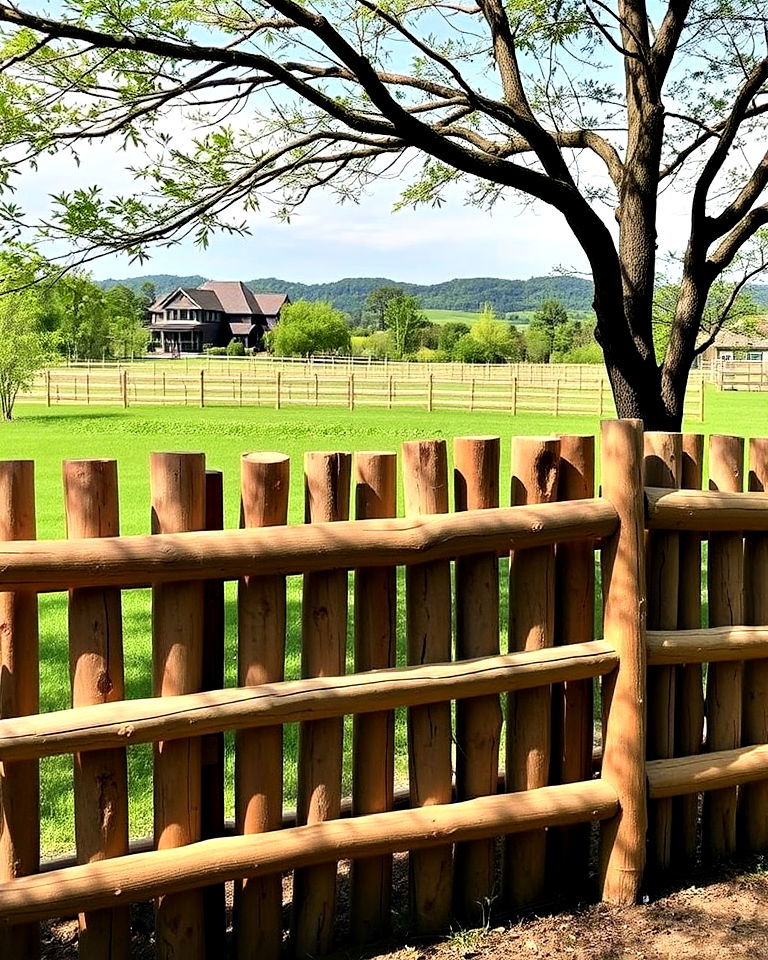
Between rustic simplicity and functionality, split rail fences are crafted from rough-hewn logs arranged horizontally. This design is reminiscent of traditional rural fencing in Japan, making it ideal for large, open spaces. Their low profile and natural wood tones complement expansive gardens or farmland while maintaining an unobtrusive presence. Split rail fences offer a laid-back charm that celebrates the beauty of organic materials in outdoor settings.
24. Waterfall Bamboo Fences
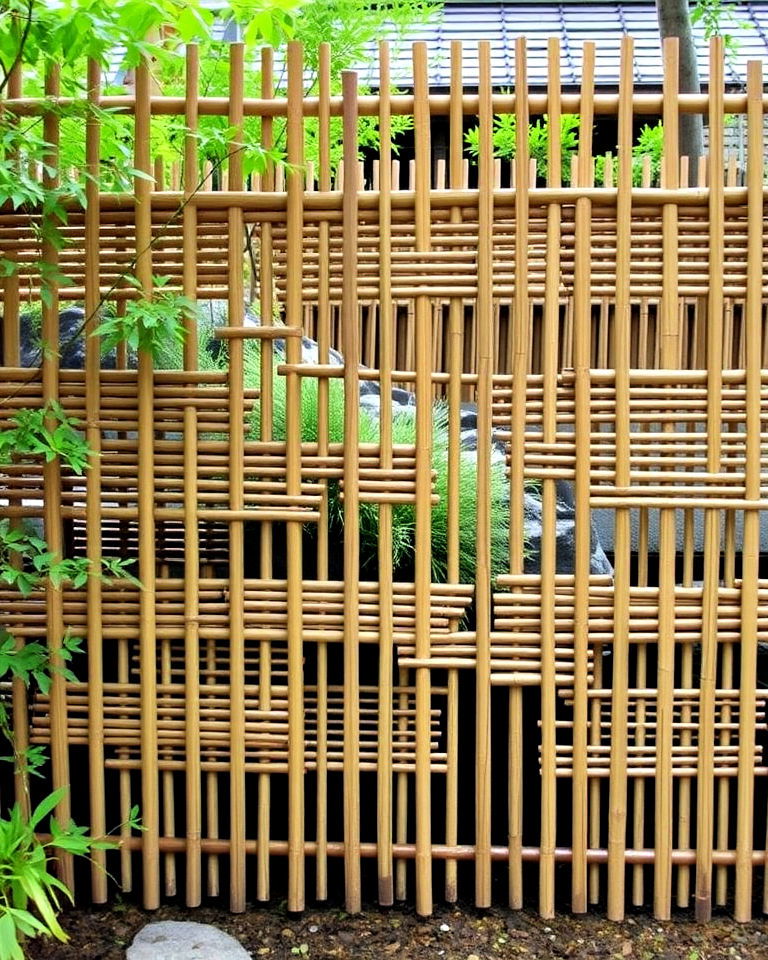
Across cascading designs, waterfall bamboo fences feature bamboo slats arranged at varying heights to mimic the flow of water. This unique structure introduces dynamic movement to gardens, creating visual interest while maintaining the natural elegance of bamboo. Ideal for framing ponds or water features, these fences emphasize the harmony of Japanese landscaping. Their intricate design reflects the artistry and balance inherent in traditional Japanese aesthetics.
25. Multi-Layered Wood Fences
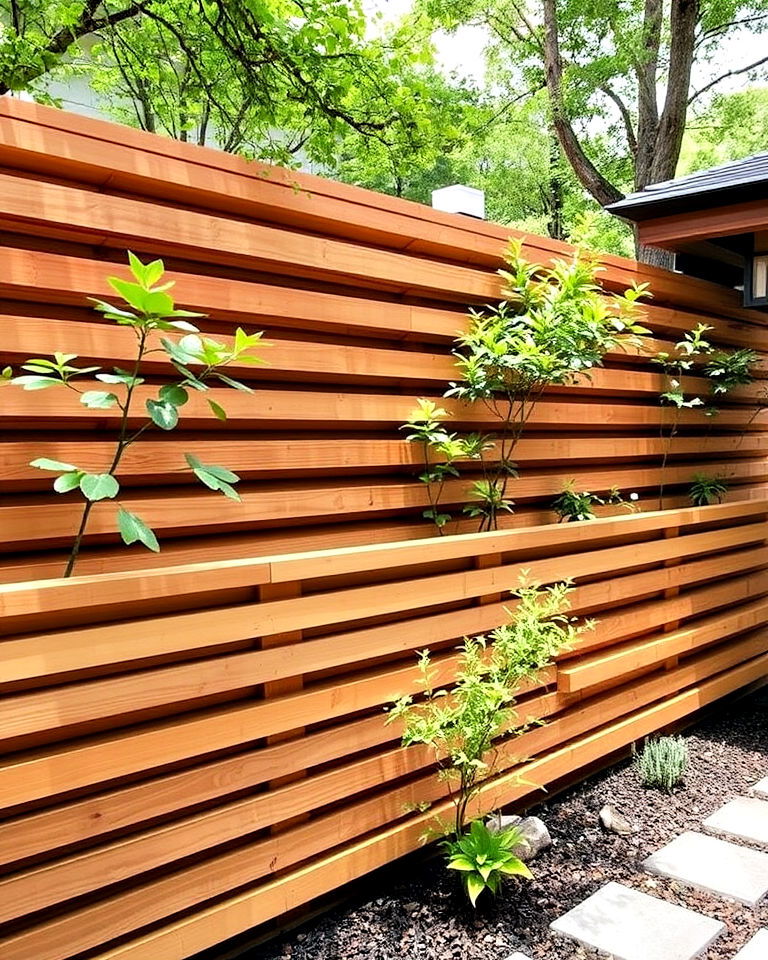
Among layered designs, multi-layered wood fences stack planks at varying depths, creating a three-dimensional effect. This innovative approach adds texture and shadow play, making it visually striking. Perfect for modern Japanese-inspired gardens, these fences offer privacy while maintaining an open, breathable feel. The natural wood tones enhance the organic vibe, blending seamlessly with greenery and other natural elements, making them both functional and decorative.
26. Wabi-Sabi Wooden Fences

Amid the charm of imperfection, Wabi-Sabi wooden fences embrace the natural flaws and textures of weathered wood. This design philosophy celebrates simplicity and transience, making these fences a perfect addition to Japanese gardens. With uneven slats and rough finishes, they exude a rustic, timeless beauty that connects with nature. Ideal for Zen gardens or pathways, Wabi-Sabi fences create a tranquil, understated barrier that reflects harmony and serenity.
27. Bamboo and Stone Fusion Fences
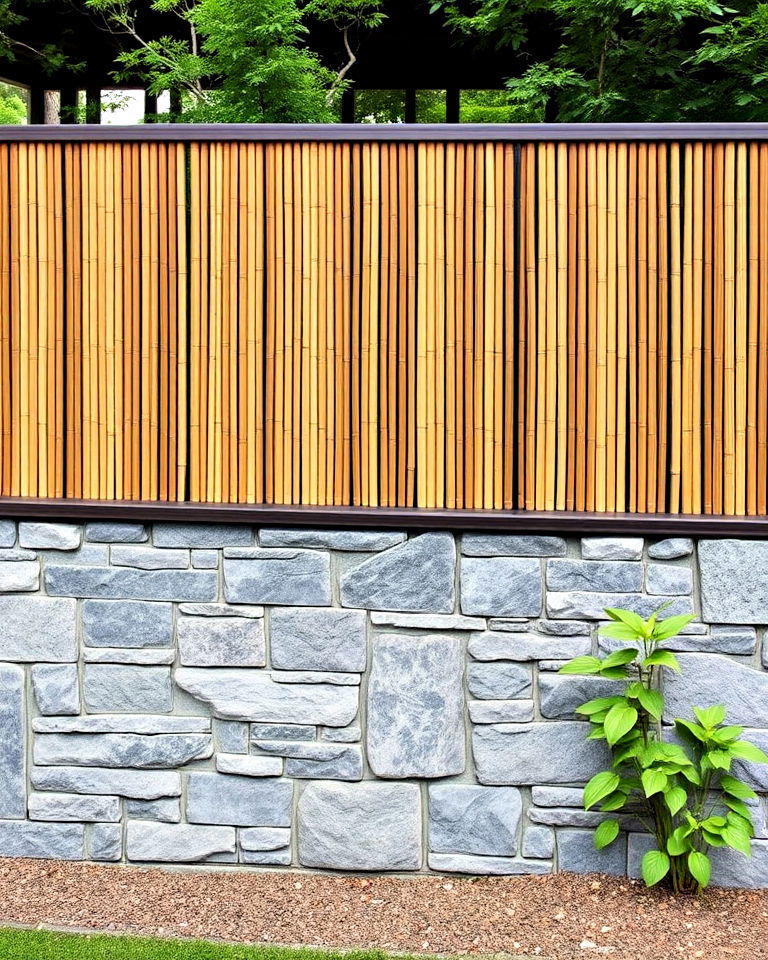
From the union of materials, bamboo and stone fusion fences combine sleek bamboo slats with sturdy stone bases. This design balances the lightness of bamboo with the durability of stone, offering both functionality and elegance. Perfect for perimeter walls or garden dividers, the contrasting textures create visual interest while blending seamlessly into natural surroundings. These fences embody the Japanese principle of balance, enhancing outdoor spaces with their timeless appeal.
28. Diamond Lattice Fences
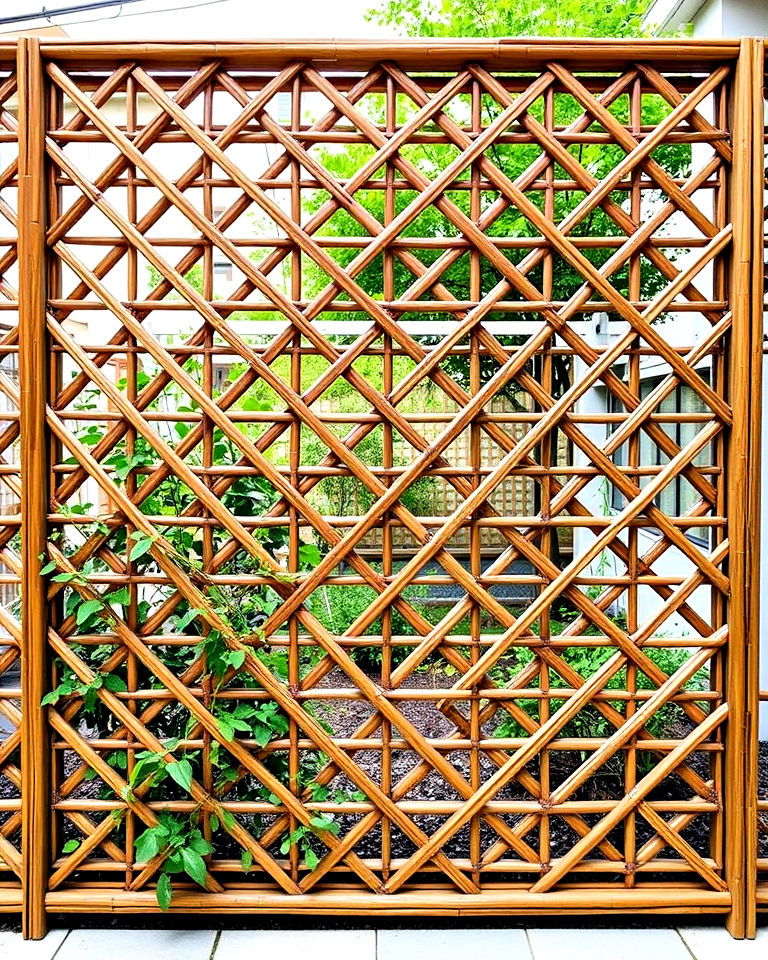
With intricate detail, diamond lattice fences feature bamboo or wood slats arranged in crisscross patterns. This unique design provides both privacy and ventilation, making it ideal for gardens and courtyards. The geometric arrangement adds visual texture while maintaining a minimalist aesthetic. Often used as trellises for climbing plants, diamond lattice fences emphasize harmony between structure and nature, creating a serene and decorative outdoor element.
29. Water Reed Fences
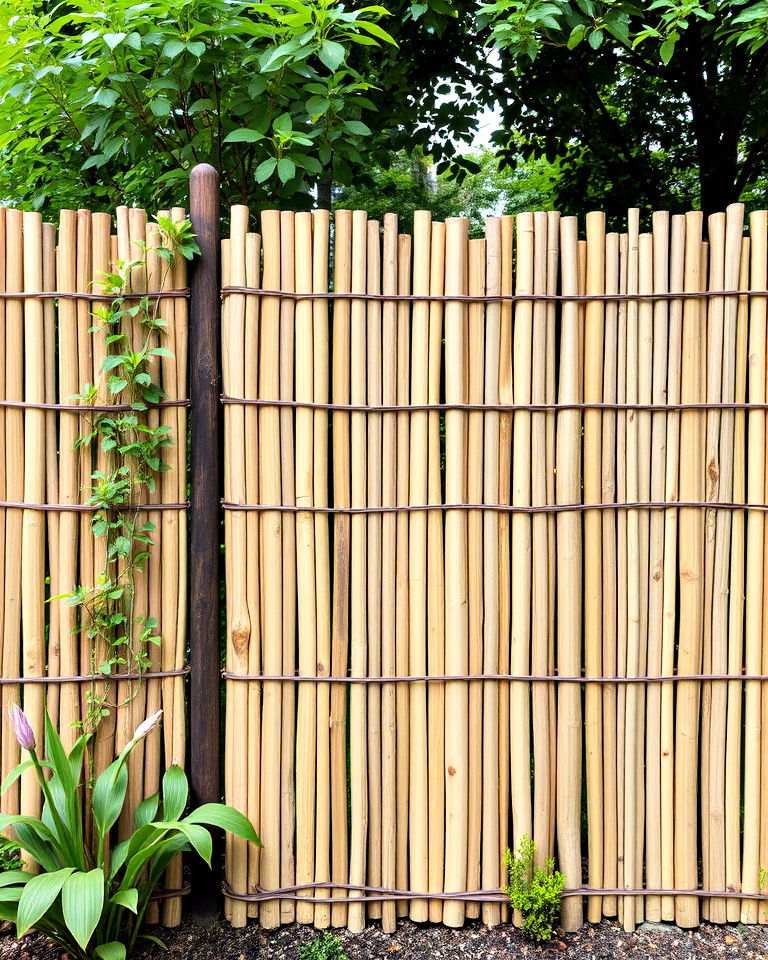
Against the backdrop of greenery, water reed fences showcase bundles of reeds tightly tied together for a natural, textured look. These lightweight fences are eco-friendly and blend effortlessly into garden landscapes. Perfect for creating privacy or framing pathways, water reed fences highlight traditional Japanese materials. Their organic texture and soft earthy tones bring warmth and charm to outdoor spaces while fostering a connection to the natural world.
30. Split-Level Fences
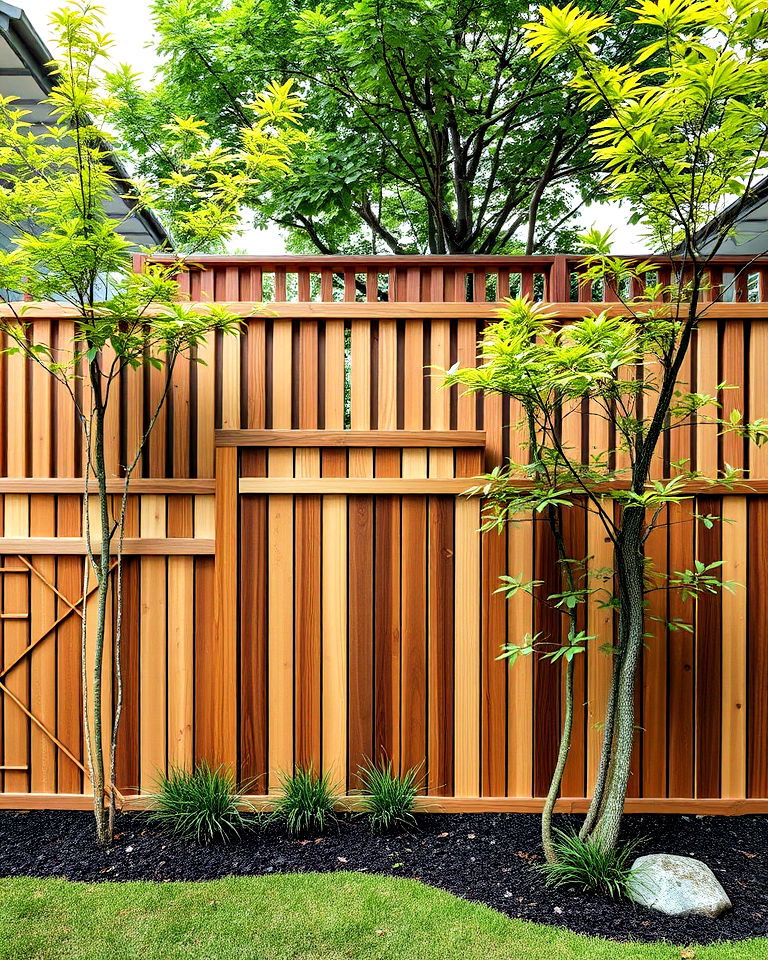
In layered compositions, split-level fences feature sections of varying heights, creating a dynamic and modern look. This design combines the principles of balance and asymmetry, common in Japanese landscaping. Perfect for defining multi-level gardens or terraced spaces, split-level fences add depth and dimension. The use of natural wood or bamboo slats enhances their connection to nature, making them both practical and visually engaging.
31. Willow Branch Fences

From handcrafted artistry, willow branch fences weave flexible willow twigs into intricate patterns. This rustic design celebrates natural materials while providing a lightweight, sturdy barrier. Ideal for small gardens or decorative accents, willow branch fences evoke traditional craftsmanship and blend seamlessly with natural surroundings. Their soft, organic look makes them a charming addition to Japanese-inspired landscapes, emphasizing simplicity and connection to nature.
32. Plank and Pebble Fences
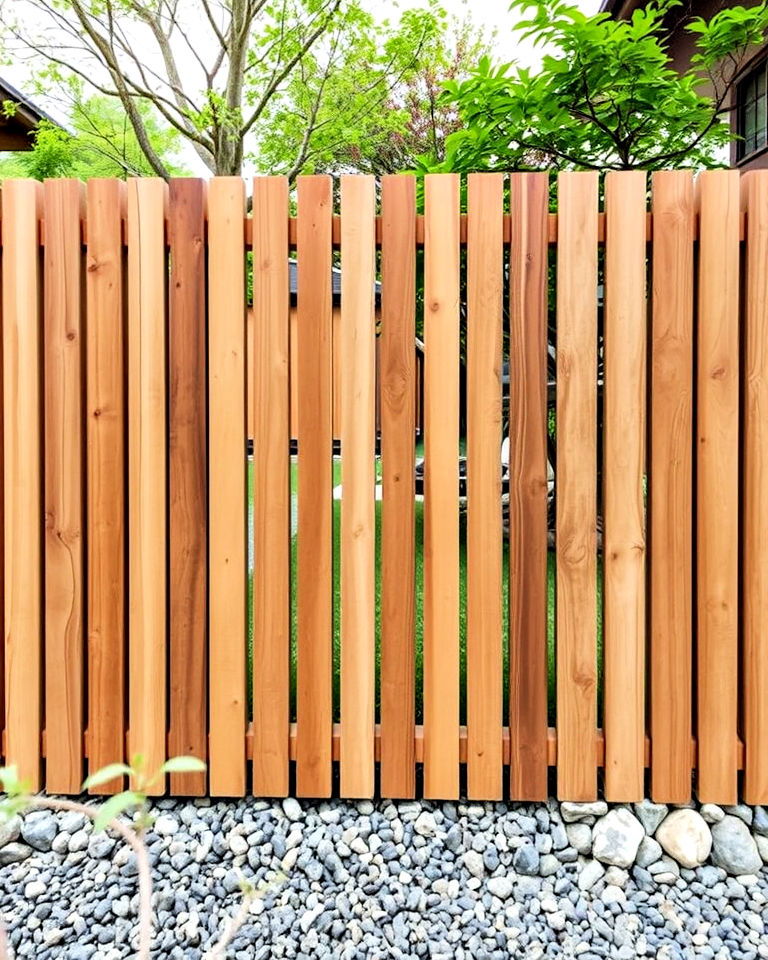
With contrasting textures, plank and pebble fences combine smooth wooden planks with stone or pebble bases. This design offers a visually striking mix of materials, perfect for framing pathways or defining garden boundaries. The natural tones of wood and stone enhance the tranquility of outdoor spaces, while the sturdy construction ensures longevity. Plank and pebble fences reflect the harmony between organic elements, embodying the Japanese design ethos of balance and simplicity.
33. Lightweight Reed Panel Fences

Through simple elegance, lightweight reed panel fences feature thin, flexible reeds bound together in minimalist panels. These fences provide subtle privacy without obstructing airflow, making them ideal for gardens or patios. Their natural, earthy tones blend effortlessly with greenery and other natural materials. Lightweight yet durable, reed panel fences are easy to install and maintain, offering a cost-effective way to bring a touch of traditional Japanese charm to outdoor spaces.
34. Shadow Box Wooden Fences
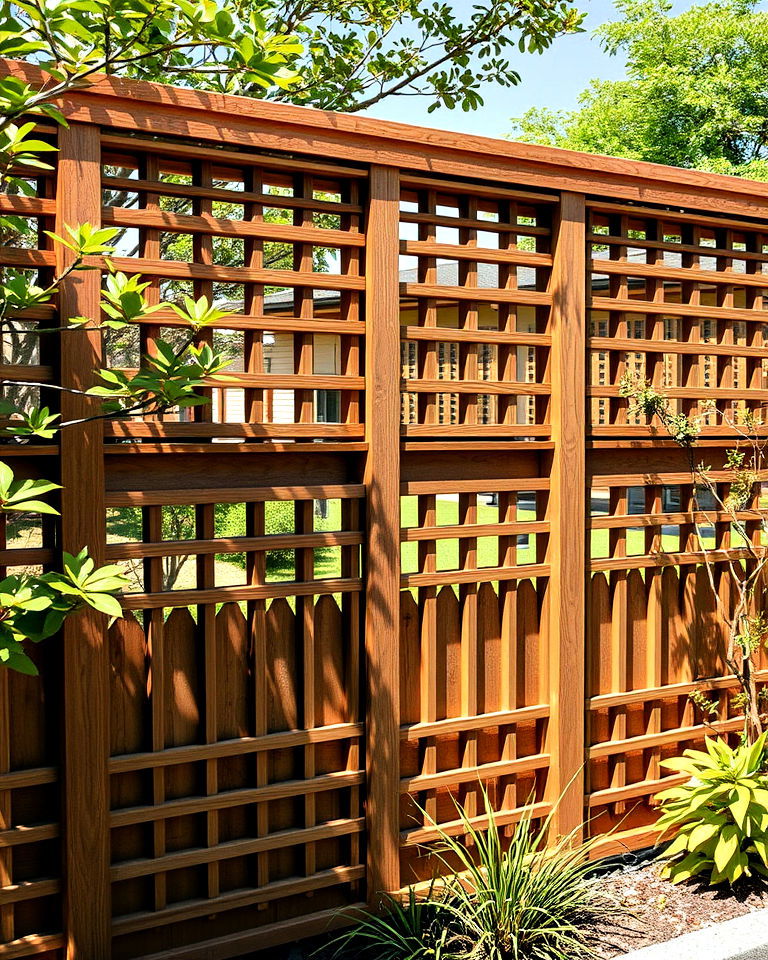
Between layers of detail, shadow box wooden fences alternate wooden slats on each side of the frame, creating a layered effect. This design offers partial privacy and allows light and air to pass through. Perfect for contemporary Japanese-inspired gardens, shadow box fences combine functionality with aesthetic appeal. The interplay of shadows and textures adds depth and dimension, making them a sophisticated choice for any outdoor setting.
35. Decorative Stone Wall Fences
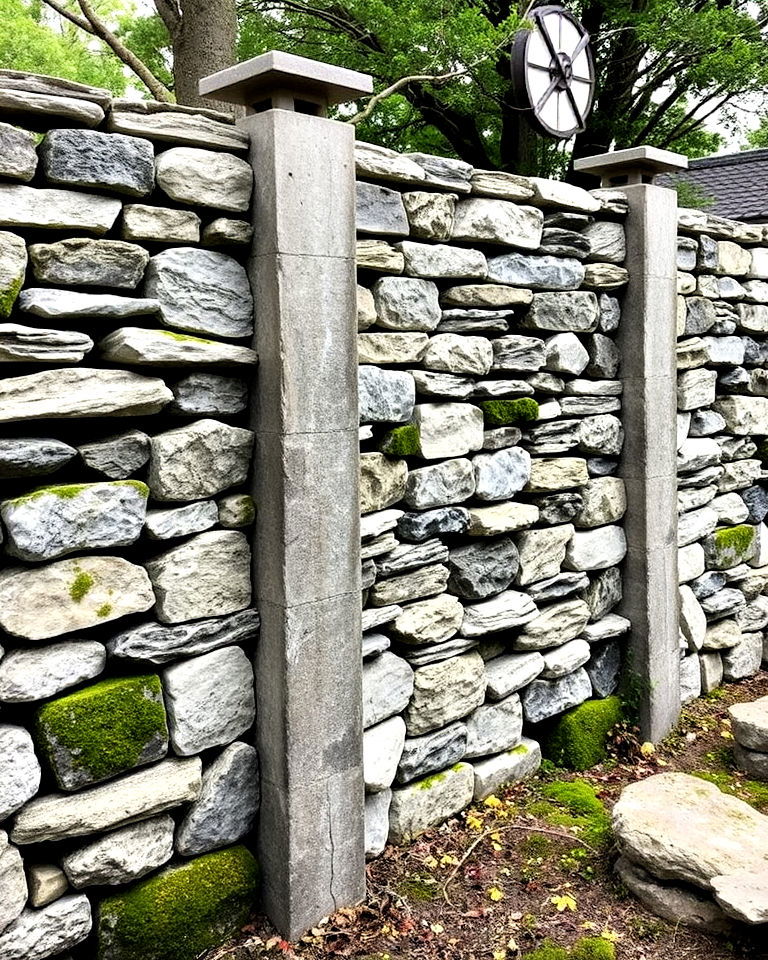
Among durable options, decorative stone wall fences feature intricately stacked stones, often with mortarless construction to emphasize craftsmanship. These robust fences offer complete privacy while maintaining a natural, organic aesthetic. Ideal for framing larger gardens or courtyards, they blend seamlessly with traditional Japanese landscaping elements such as moss and water features. The timeless elegance of stone ensures these fences remain visually appealing for years to come.
36. Minimalist Metal and Wood Fences
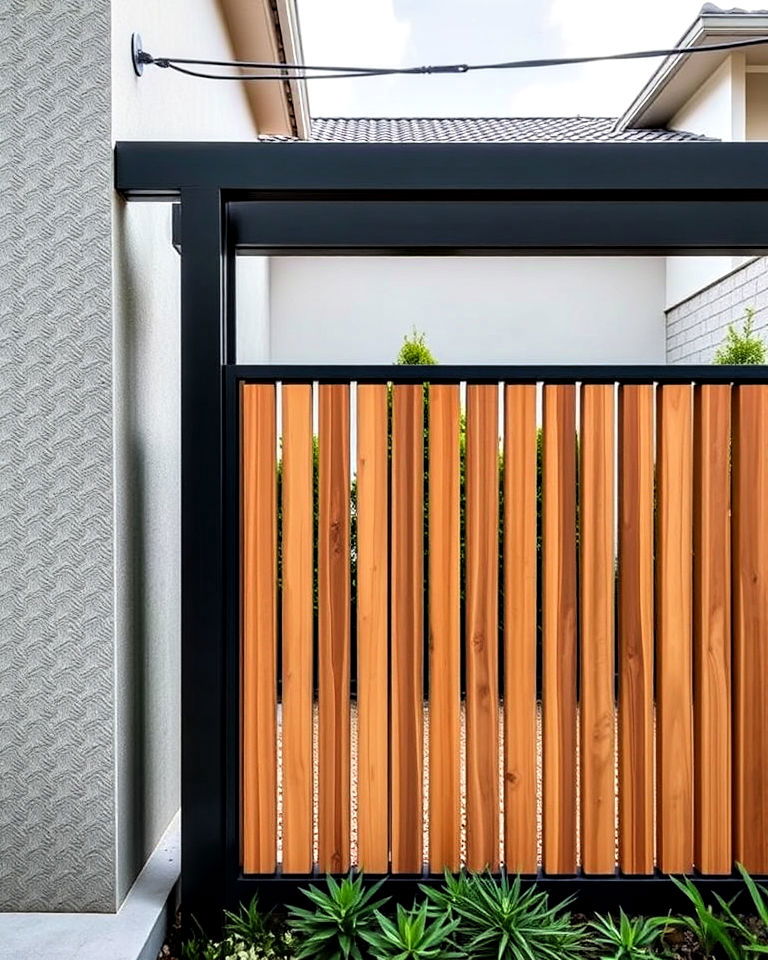
In contemporary blends, minimalist metal and wood fences pair sleek metal frames with warm wooden slats. This modern design emphasizes clean lines and simplicity, perfect for urban Japanese-inspired spaces. The contrasting materials create a striking visual balance, offering durability and style. These fences work well for both privacy and decoration, bringing a fresh, modern twist to traditional Japanese fencing concepts while maintaining harmony with natural elements.
37. Tall Bamboo Screen Fences
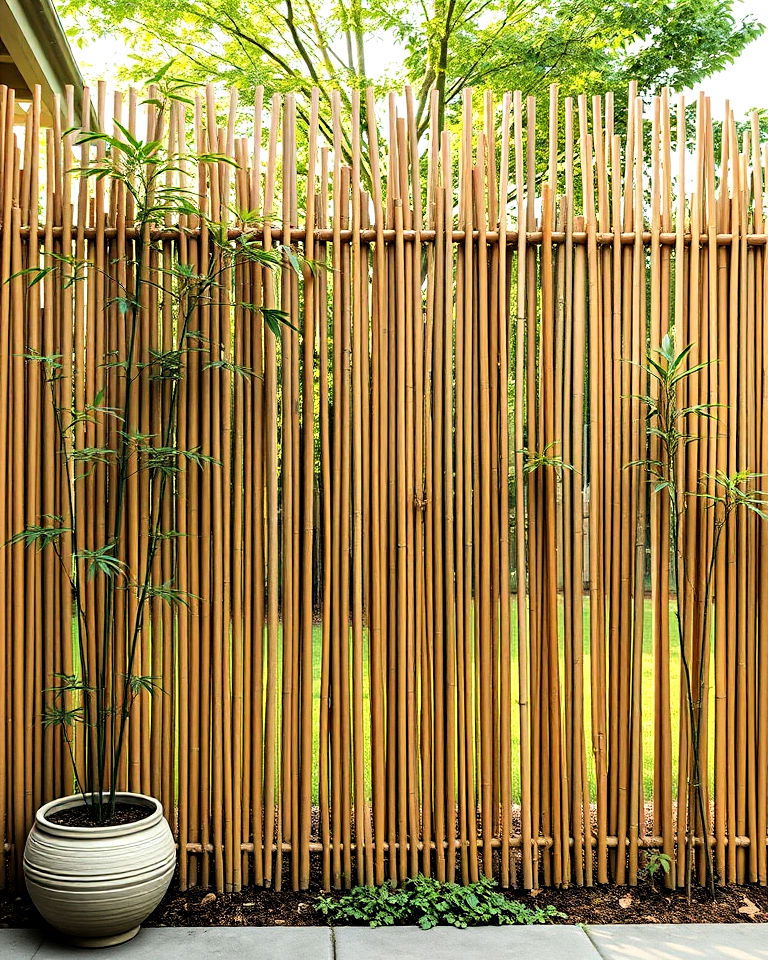
Throughout expansive spaces, tall bamboo screen fences create private enclosures while preserving a sense of openness. Their slender stalks, arranged closely together, provide a strong yet lightweight barrier. Perfect for larger gardens or patios, these fences enhance verticality and blend effortlessly with lush greenery. Tall bamboo screens emphasize traditional aesthetics while offering practical solutions for privacy and wind protection.
38. Wooden Post and Rope Fences
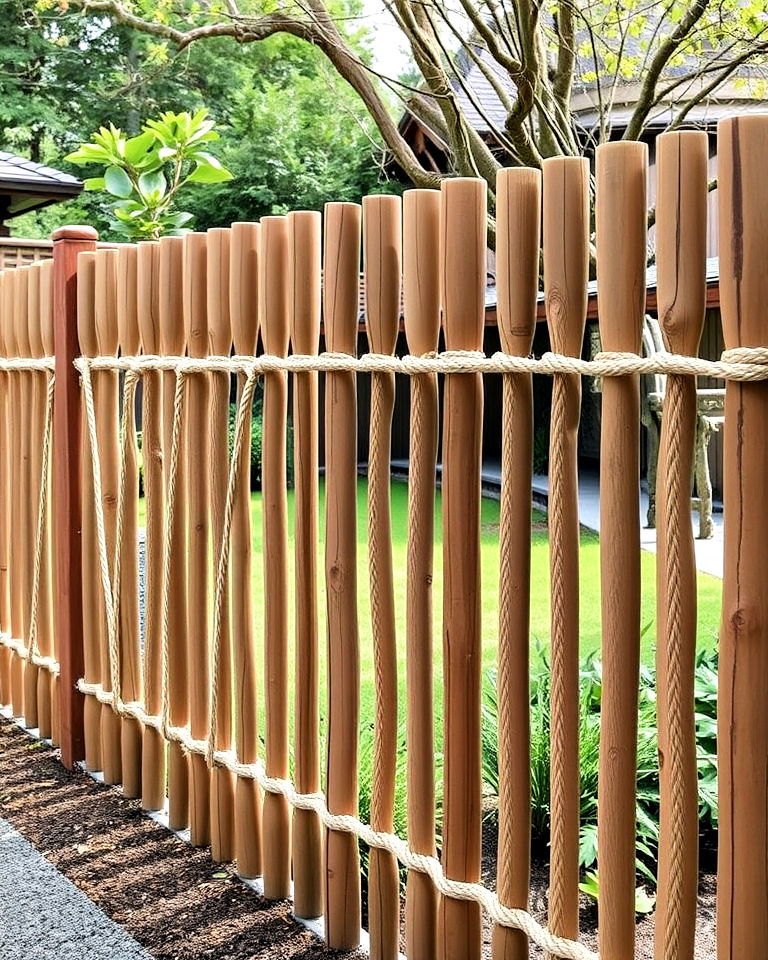
Amid rustic simplicity, wooden post and rope fences use thick posts connected by sturdy natural fiber ropes. Ideal for marking garden pathways or enclosing Zen spaces, this design is functional and unobtrusive. The combination of earthy wood tones and rough-textured ropes creates a cohesive, natural look. These fences are perfect for spaces emphasizing simplicity and practicality while blending seamlessly with natural landscapes.
39. Layered Stone and Moss Fences
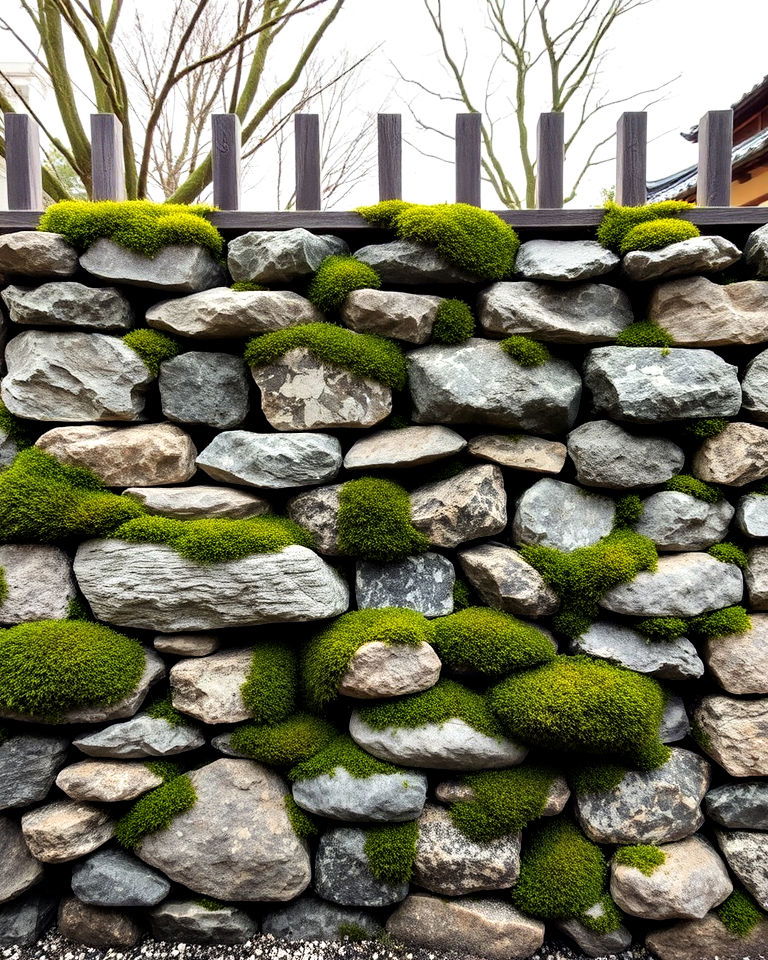
Beneath a timeless exterior, layered stone and moss fences showcase weathered stones arranged to incorporate patches of lush moss. This design emphasizes the beauty of age and nature, ideal for framing Zen gardens or tea houses. The contrast between the hard stone and soft moss creates a captivating visual texture. These fences reflect traditional Japanese reverence for natural materials and their transformation over time.
40. Decorative Wooden Lattice Fences
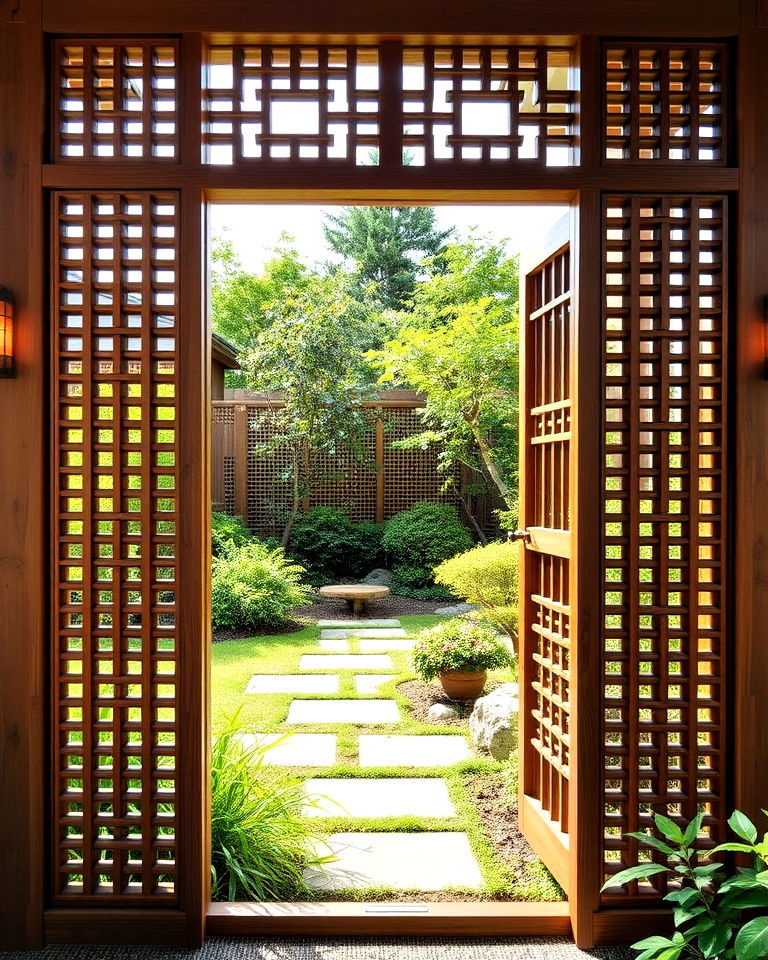
From intricate craftsmanship, decorative wooden lattice fences feature detailed, geometric patterns within wooden frames. These fences provide partial privacy while adding elegance to garden spaces. Often used to frame entrances or accent walls, they blend artistry with functionality. The natural wood tones harmonize with greenery, making them a versatile addition to any Japanese-inspired outdoor setting. Their intricate design highlights the precision and beauty of traditional Japanese craftsmanship.
Conclusion
Japanese-inspired fences are a beautiful way to bring harmony and tranquility to your garden. From the classic appeal of bamboo panel fences to the intricate details of shoji-inspired designs, each option offers a unique way to enhance your outdoor space. Whether you prefer the natural textures of woven bamboo or the minimalist elegance of black-stained wooden fences, these ideas cater to a variety of tastes and garden styles. By incorporating elements like stone, wood, and moss, you can create a serene retreat that reflects the timeless beauty of Japanese garden design. Let these **40 Japanese fence ideas for serene gardens** guide you in crafting a space that feels both peaceful and deeply connected to nature.

Leave a Reply